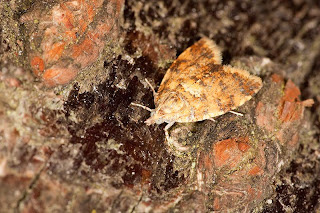Minimum temp 15.1 Centigrade
Moth species count 34
Total moth count 122
I got up for dawn and landscapes, but it was dull with amorpous grey cloud, as well as windy. The worst weather for landscapes, so I stayed in.
Moths included the tiny
Phyllonorycter geniculella which was new to the garden:
 This image was taken with a 40D and MP-E65 at 3x lifesize. Fill flash was from an MT24EX.
This image was taken with a 40D and MP-E65 at 3x lifesize. Fill flash was from an MT24EX. Eudonia truncicolella.
Eudonia truncicolella.
This is a common species that flies between July and August in woodland.
 Grey/dark dagger (Acronicta tridens/psi)
Grey/dark dagger (Acronicta tridens/psi)

Timothy tortrix (Aphelia paleana)
It flies in June to August in damp, rough ground. Note it is plain with a yellowish tinge.
 Barred straw (Eulithis pyraliata)
Barred straw (Eulithis pyraliata) This moth flies from late May to late August in all but northern Scotland. It is found in gardens, woodland, roadside verges and rough grassland.
 Dark arches (Apamea monoglypha)
Dark arches (Apamea monoglypha)
Silver Y (Autographa gamma)Interestingly there were 6 of these in the trap this morning having had less than this all year, despite seeing upto 20 feeding in the garden at dusk on the red and white valerian.
 Diamond-back moth (Plutella xylostella)This species of micromoth migrates to Britain from mainland Europe.This is another photo taken at greater than lifesize with the MP-E 65 at 2.5x lifesize.
Diamond-back moth (Plutella xylostella)This species of micromoth migrates to Britain from mainland Europe.This is another photo taken at greater than lifesize with the MP-E 65 at 2.5x lifesize.






































































